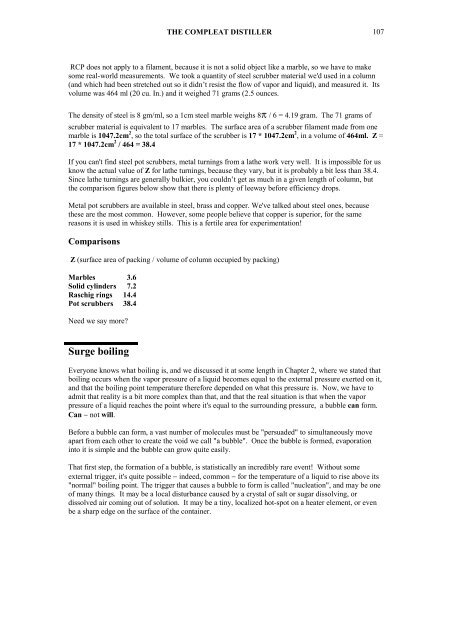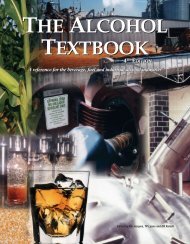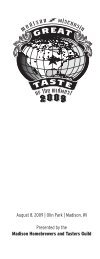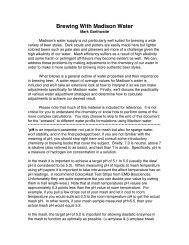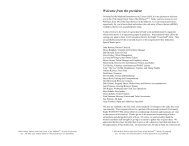The Compleat Distiller
The Compleat Distiller
The Compleat Distiller
You also want an ePaper? Increase the reach of your titles
YUMPU automatically turns print PDFs into web optimized ePapers that Google loves.
THE COMPLEAT DISTILLER 107<br />
RCP does not apply to a filament, because it is not a solid object like a marble, so we have to make<br />
some real-world measurements. We took a quantity of steel scrubber material we'd used in a column<br />
(and which had been stretched out so it didn’t resist the flow of vapor and liquid), and measured it. Its<br />
volume was 464 ml (20 cu. In.) and it weighed 71 grams (2.5 ounces.<br />
<strong>The</strong> density of steel is 8 gm/ml, so a 1cm steel marble weighs 8 / 6 = 4.19 gram. <strong>The</strong> 71 grams of<br />
scrubber material is equivalent to 17 marbles. <strong>The</strong> surface area of a scrubber filament made from one<br />
marble is 1047.2cm 2 , so the total surface of the scrubber is 17 * 1047.2cm 2 , in a volume of 464ml. Z =<br />
17 * 1047.2cm 2 / 464 = 38.4<br />
If you can't find steel pot scrubbers, metal turnings from a lathe work very well. It is impossible for us<br />
know the actual value of Z for lathe turnings, because they vary, but it is probably a bit less than 38.4.<br />
Since lathe turnings are generally bulkier, you couldn’t get as much in a given length of column, but<br />
the comparison figures below show that there is plenty of leeway before efficiency drops.<br />
Metal pot scrubbers are available in steel, brass and copper. We've talked about steel ones, because<br />
these are the most common. However, some people believe that copper is superior, for the same<br />
reasons it is used in whiskey stills. This is a fertile area for experimentation!<br />
Comparisons<br />
Z (surface area of packing / volume of column occupied by packing)<br />
Marbles 3.6<br />
Solid cylinders 7.2<br />
Raschig rings 14.4<br />
Pot scrubbers 38.4<br />
Need we say more?<br />
Surge boiling<br />
Everyone knows what boiling is, and we discussed it at some length in Chapter 2, where we stated that<br />
boiling occurs when the vapor pressure of a liquid becomes equal to the external pressure exerted on it,<br />
and that the boiling point temperature therefore depended on what this pressure is. Now, we have to<br />
admit that reality is a bit more complex than that, and that the real situation is that when the vapor<br />
pressure of a liquid reaches the point where it's equal to the surrounding pressure, a bubble can form.<br />
Can − not will.<br />
Before a bubble can form, a vast number of molecules must be "persuaded" to simultaneously move<br />
apart from each other to create the void we call "a bubble". Once the bubble is formed, evaporation<br />
into it is simple and the bubble can grow quite easily.<br />
That first step, the formation of a bubble, is statistically an incredibly rare event! Without some<br />
external trigger, it's quite possible − indeed, common − for the temperature of a liquid to rise above its<br />
"normal" boiling point. <strong>The</strong> trigger that causes a bubble to form is called "nucleation", and may be one<br />
of many things. It may be a local disturbance caused by a crystal of salt or sugar dissolving, or<br />
dissolved air coming out of solution. It may be a tiny, localized hot-spot on a heater element, or even<br />
be a sharp edge on the surface of the container.


